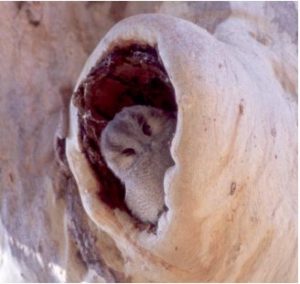 Mature trees are pillars of biodiversity in the ecosystem. They provide habitat for wildlife, nurseries for seeds to grow and facilitate vital soil processes. Mature trees with natural hollows are disappearing from the ACT due to agriculture and urban development. This is significant because hollows are home to many native birds and animals and without these trees they may be threatened or leave the area, which threatens the biodiversity of our beautiful city.
Mature trees are pillars of biodiversity in the ecosystem. They provide habitat for wildlife, nurseries for seeds to grow and facilitate vital soil processes. Mature trees with natural hollows are disappearing from the ACT due to agriculture and urban development. This is significant because hollows are home to many native birds and animals and without these trees they may be threatened or leave the area, which threatens the biodiversity of our beautiful city.
Loss of native hollow-bearing trees in the ACT has been nominated as a ‘Key Threatening Process’ under the Nature Conservation Act 2014. This nomination was made by the Conservation Council ACT Region, Friends of Grasslands, Australian Native Plant Society Canberra Region, Canberra Ornithologists Group and the Field Naturalists Association of Canberra. If accepted as a Threatening Process an action plan will be developed to reduce the impact of the process.
Consultation for this nomination is now open for public comment until 9 June 2017.
Why does it matter?
Hollows are cavities that form in branches or trunks of living and dead trees. Formation of hollows is a slow process, initiated by wind damage, natural branch shedding, termite galleries and other boring insect damage, lightning, fire damage and internal fungal or bacterial decay. It can take more than 120 years for a tree to develop hollows suitable for small nesting sites and more than 200 years for larger hollows.
Hollow-bearing trees provide many functions that improve the health of the land and protect biodiversity, including:
- Providing nesting, nesting materials, roosting, feeding and shelter for wildlife.
- Creating genetic diversity of some vegetation communities.
- A contribution to soil conservation and stability, water quality, air quality, nutrient cycling and carbon sequestration.
- Pest management by providing shelter for insectivores such as bats and birds.
- Creating biodiversity by facilitating dispersion and migration, which in turn may aid species adaptation in the face of climate change.
- Heritage landscape values (e.g. Aboriginal scar trees or trees within culturally important areas).
- Other benefits in modified landscapes (e.g. improved mental health for residents, shade, mitigating against ‘heat island effect’, increasing residential property prices).
 The number of mature hollow-bearing trees in an area impacts the number of species the area can support. It is estimated that 15% of all birds, 31% of mammals, 10% of reptiles and 13% of all amphibians in Australia use hollows.
The number of mature hollow-bearing trees in an area impacts the number of species the area can support. It is estimated that 15% of all birds, 31% of mammals, 10% of reptiles and 13% of all amphibians in Australia use hollows.
Many species are very selective of the hollows they use and there may only be a small percentage of these hollows available in any particular area.
Fauna species in the ACT that rely on hollow-bearing trees include possums, gliders, owls, parrots, cockatoos, pardalotes, antechinus, ducks, kingfishers as well as numerous species of bats, snakes, frogs, lizards and invertebrates. (Swift parrots pictured)
Nesting boxes have helped, however nesting boxes are not a viable alternative for most species and should not be considered a replacement for natural hollows.
Why are these trees being lost?
Mature hollow-bearing trees are being lost for reasons including: agricultural purposes, urban development, firewood collection, dieback and altered fire regimes, lack of natural tree recruitment (e.g. elevated nutrients or stock grazing), lack of restoration planting efforts that limit the number of regenerating seedlings and also through the use of hollows by other means (e.g. feral honeybees, Common Myna and Common Starling).
While planning of new urban areas has attempted to save large trees within the urban landscape, the fate of these trees is not guaranteed and they are frequently removed for safety reasons or for further infrastructure. A more considered tree retention strategy is required in urban landscapes to retain a more diverse tree size structure.
How can we protect these trees?
In the ACT we can take many actions to mitigate the loss of hollow-bearing trees including:
- Protect existing dead mature trees.
- Protect trees with hollows.
- Protect trees that have reached approximately 67% of their maximum diameter.
- Maintain a range of different tree sizes which is essential for the continued renewal of the tree hollow resource.
- Maintain connectivity – linkages of habitats at a range of temporal and spatial scales.
- Retain and enhance landscape heterogeneity.
- Retain and enhance stand structural complexity including multiple aged cohorts, living and dead trees, logs.
- Manage stock and control feral animal grazing.
- Provide buffer plantings around isolated trees.
What can you do?
The ACT Scientific Committee is consulting the public on the nomination of the loss of native hollow-bearing trees as a ‘Key Threatening Process’. Comments are open until 9 June 2017. It is essential that we protect mature hollow-bearing trees and the values they possess. Help us ensure that these pillars of biodiversity have a continued presence in the landscape.
Read the Threatening Process Nomination for more information. Download this page as a two-page flyer here.
Make a submission or comment by 9 June 2017 to: Scientific Committee, Environment, Planning and Sustainable Development Directorate, GPO Box 158, CANBERRA ACT 2601 or email: epsddcomms@act.gov.au
See www.conservationcouncil.org.au to be kept up to date with this nomination.
Contact: Larry O’Loughlin, Executive Director. T: (02) 6229 3202 E: director@conservationcouncil.org.au
